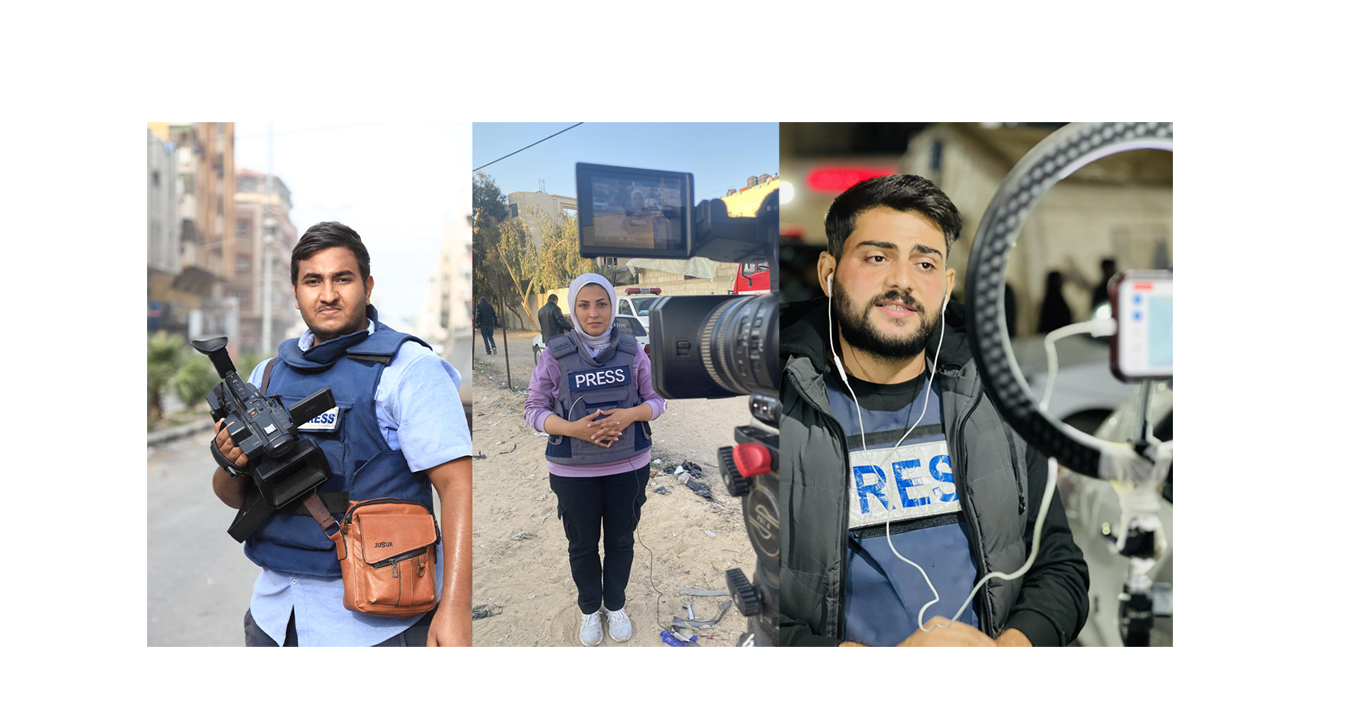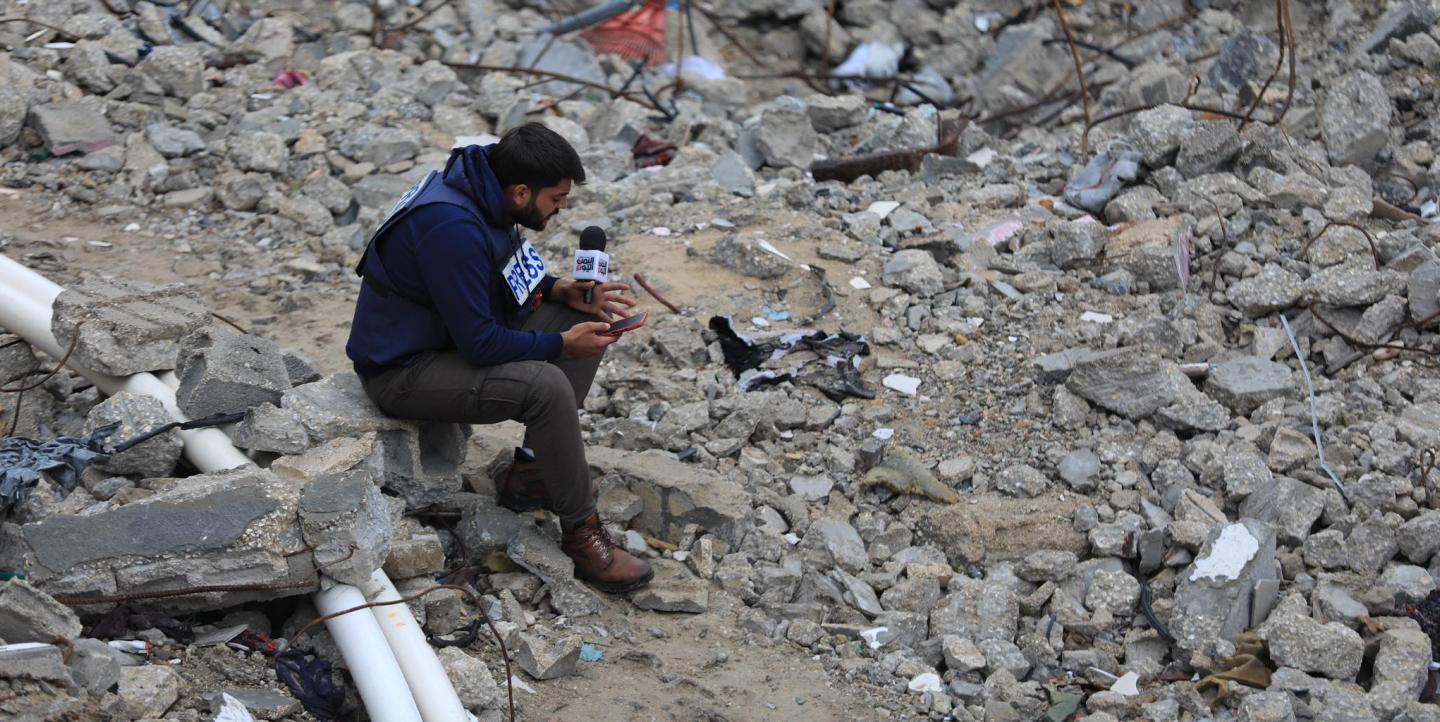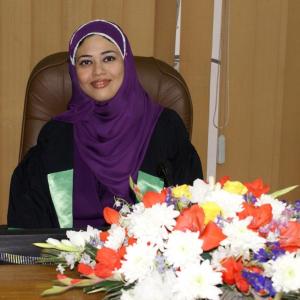Almost 80 Palestinian journalists and media workers have been killed since the outbreak of the Israel-Hamas war in October. They are among the more than 28,000 Palestinians killed by Israeli airstrikes and during its ground invasion, according to the Gaza Ministry of Health.
Journalists in Gaza have been displaced, their homes destroyed. They’ve also lost critical reporting equipment, compounding the already significant challenges they face covering the Israel-Hamas war in a deadly conflict zone.
In a reporting contest run by ICFJ's Arabic-language Crisis Reporting Forum, four journalists – Samar Medhat, Marina Milad, Tala Al-Sharif, and Nada Omran – were recognized for their impactful coverage of the war and its destruction.
We share their stories below, along with testimonies from other journalists in our network who continue to report while in harm’s way inside Gaza:
A journalist detained
Tala Al-Sharif produced a video report telling the story of fellow journalist Lama Ghosheh, who Israeli authorities arrested and convicted for allegedly inciting violence on social media.
While detained ahead of her trial, Al-Sharif was allegedly harassed, and placed in solitary confinement. She ultimately was convicted and sentenced to three years of house arrest, which was later commuted to a three-year suspended sentence and a fine. Throughout, she has been banned from accessing social media.
“My story’s heroine, Lama, became interested in journalism when she was a kid. She lived throughout the conflict in Palestine and expressed her feelings by writing,” said Al-Sharif. “[Ghosheh] specialized in writing stories about the marginalized groups in Jerusalem, until the conflict escalated and she herself became one of the humanitarian cases she writes about.”
Homes destroyed
In a multimedia report titled “Palestine Tower,” Marina Milad documented the suffering of Palestinians whose houses have been destroyed during the war.
Home to dozens of families, and one of the oldest apartment buildings in the vibrant Gaza City neighborhood of Al-Rimal, Palestine Tower was destroyed on October 7 by an Israeli airstrike. The Israeli military claimed the building held Hamas intelligence infrastructure.
"The 14-story Palestine Tower is one of the oldest towers, located in the Al-Rimal neighborhood. It was built in 1994,” said Milad. “[Palestine Tower] residents come from different social classes, and it is the home of various media outlets and stores. I chose it to show the lives of its residents during the war.”
Israeli forces have reduced the Al-Rimal neighborhood to rubble during their attacks.
Reproductive health consequences
Nada Omran reported a story for Cairo 24 about how finding sanitary pads in Gaza has become impossible due to the scarcity of supplies, a situation exacerbated by the lack of water. In this context, she found, women and girls in Gaza take birth control pills to delay their periods.
"I wanted to expose another side of the war, outside of the bombing and killing, by displaying the anguish of women and girls about their monthly suffering,” said Omran. "I supported the report with statistics and figures from the Palestinian Central Bureau of Statistics and the World Health Organization.”
Samar Medhat wrote an article that examined how pregnant women in Gaza have been forced to undergo C-section deliveries without painkillers or anesthesia during the war. Her story shined a light on the trauma experienced by women giving birth outside of operating rooms, surrounded by wounded people screaming out in pain.
"In my report I mentioned statistics on pregnant women in Gaza, the figures of difficult childbirth operations [and] the figures of women who lost their uteruses during a C-section,” Medhat said. Her piece included a map of hospitals that provide OBGYN services, as well as those that have been shut down or destroyed. She also incorporated testimonies from doctors about the tragedies pregnant women have faced.
"I experienced significant challenges in reaching women who gave birth by C-section in difficult circumstances and had serious consequences. The other challenge was determining the number of C-sections, which I obtained from the data available through official health associations,” said Medhat.

Displaced and in harm’s way
Palestinian journalists are figuring out how to continue their reporting while keeping themselves and their families safe. Members of our network are among these journalists.
Nour Swirki, a TV reporter and writer, lived in Gaza City before being displaced to Rafah, on the southern border with Egypt. "Our lives have been turned upside down,” she said.
Most journalists have left their equipment behind in destroyed homes, and are struggling today from a lack of fuel, transportation and safety equipment, explained Swirki.
"I focus my reporting on women and children,” she said. “The most touching humanitarian story I have ever written about was a 10-year-old boy who needed dialysis sessions. While his family was relocating after being displaced, his father was arrested, and the kid remained in the street until one neighbor recognized him and took him to his sessions.”
Yemen Today correspondent Abd Elhady Nabeel Farhat and his family were forced to leave northern Gaza during the war. Farhat has reported on Israeli attacks on Al-Shifa Hospital and its role as a flashpoint in the war. "The most prominent challenge I faced was homelessness and displacement, especially since I am from northern Gaza. My equipment was damaged in Al-Shifa during the bombing of buildings,” he said.
Farhat has continued to report, with limited equipment, from Al-Aqsa Hospital, the only functioning hospital left in central Gaza. "The armor we wear has no anti-shrapnel materials or mechanisms,” he continued. “Losing equipment has hampered our coverage, and as a result many humanitarian stories have yet to be told."
Photographer Mostafa Garrour has lost many of his colleagues during the war, and he was displaced along with his family from northern Gaza to Deir Al-Balah in central Gaza. Garrour said one of the most important stories he published was about an elderly Palestinian woman who was unable to receive cancer treatment early in the war. The woman later died because the nearby hospital had ceased operating after running out of fuel, power and water.
Mohammed Fayez Abo Oun abandoned his filmmaking equipment when he fled to Deir Al-Balah, after his home in Gaza City was destroyed.
"I work without any protection. No armor. No helmet. No camera, and currently I report via my mobile phone,” he said. “There are many untold stories, such as the destruction of residential buildings in northern Gaza and the mass graves there.”
Image courtesy of Abd Elhady Nabeel Farhat.
This article was originally published on IJNet Arabic and translated by Lina ElShrief. It was updated on February 12.


